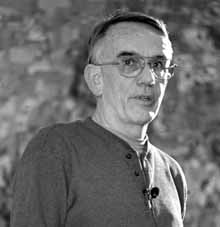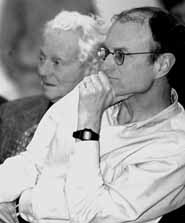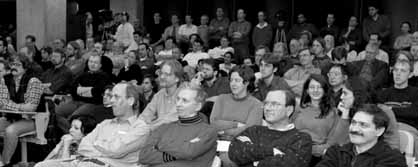 |
|
Linear Collider Series Could Go the Distance by Mike Perricone
Playing up a baseball theme, "LINE DRIVE: A Fermilab Series of Linear Collider Double-Headers" drew a standing-room-only crowd of more than 200 to Wilson Hall's 1 West conference room for opening day on January 18. And especially during the extra innings for questions and answers, there were pointed lessons about the stakes and the level of competition. "From the standpoint of opening up the debate, I'd say it was a success," said physicist Hugh Montgomery of Fermilab's Particle Physics Division, the series organizer. "The discussion was energetic." Fermilab Director Michael Witherell made the first pitch by describing himself as "the old has-been lobbing the ball to home plate." But he made it clear that a pennant is at stake in choosing the next-generation machine to follow the Large Hadron Collider being built at CERN, the European Particle Physics laboratory. And he pointed to a critical road trip to Snowmass, Colorado in July, concurrent with a meeting of the subpanel of the High Energy Physics Advisory Panel.
Witherell reiterated that the Linear Collider workshop at Fermilab in October had included the announcement of a worldwide panel to evaluate technical proposals using a common framework such as luminosity. He emphasized that the European and Japanese HEP communities had already reached the first decision point of a willingness to explore a linear collider. For example, the German laboratory, DESY, will make a proposal on its superconducting TESLA concept in March, for presentation to the German governmental agency funding scientific research. Witherell cautioned that the U.S. community "would not be able to mount a greater scale of R&D until a decision about the physics potential is made." The decision process on a possible electron-positron linear collider, Witherell explained, hinged on two issues: the machine's physics discovery potential, and the feasibility of building the accelerator with at least one of two technological approaches, either "warm" or superconducting. Physicist Paul Grannis, of the DZero collaboration and the State University of New York at Stony Brook, made the case for a linear collider, and then came the questions--hard and fast. Stressing throughout that the cost of a linear collider required an international approach, Grannis described a "staged" linear collider beginning operations at an energy level of 500 GeV. Such a machine would be about 26 kilometers long, essentially encompassing two LINACs, each about 10 km in length, joined at a slight angle at the collision point. While initial estimates reached $5.1 billion in a 1999 Department of Energy review, Grannis said estimates since then have decreased about 30 percent to around $3.7 billion. These costs reflect the cost of an accelerator in current dollars, before inflation, contingency and cost of detectors.
He made clear his feelings that the case for a linear collider was independent of future LHC findings, and that a 500 GeV machine was an "inevitable" decision for the high-energy physics community.
"The physics case for the linear collider with a first stage at approximately 500 GeV is very strong," he concluded. "We need a linear collider to study electroweak symmetry breaking in any scenario. We know enough to make the choice now." But as renowned former Baltimore Orioles manager Earl Weaver once said, you can't hold the ball and run out the clock in baseball. The other guys have to get their at-bats. And the other guys took some hard swings. Fermilab theorist Chris Hill questioned what he called "the implicit notion" that the case for a Very Large Hadron Collider depended on results from LHC, but a linear collider did not. "I think we have that backwards," Hill said. "VLHC is a wide-band discovery machine at the energy frontier. The [linear collider] is a narrow-band precision measurement machine, needing well-defined targets. Building an LC with nothing specific to study would be a disaster. At 500 GeV, very interesting things may be out of reach. When we know we have the Higgs and supersymmetric or new strongly interacting particles within range, and a theory to accommodate them, then an LC may be desirable for precision measurements."
Hill continued: "Would we rather see a small part of the new spectrum measured with ultra-high precision? Or would we rather see a wide array of new particle states each measured to within a few percent?"
"IF the Higgs is light, the physics argument is clear, and [LC] could be a great opportunity," Amidei said. "But what we do about the IF is complicated by a number of obvious strategic and political issues about the future of the field. I think what many people want is to get beyond the predictable physics argument, and have the strategic issues enumerated and discussed somewhere besides the hallways and the [HEPAP] subpanel." The "physics potential" of a machine should not be confused with a "potential discovery guarantee," said Avi Yagil of CDF. He stressed the importance of basic knowledge as an ongoing journey. "The issue which we as a community must understandóand explain to the publicóis that we are engaged in an exploration," Yagil said. "It is hard to justify ëgambling of billions of dollars' as some will describe a plan to build any new machine. On the other hand, a mission to explore a big portion of our universe may be looked upon differently." The "Line Drive" series continued on January 25 with presentations by Steve Holmes, Fermilab's associate director for accelerators, on the parameters of the next-generation linear collider; and by theorist Andreas Kronfeld on Higgs physics at the machine. Kronfeld, along with Slawek Tkaczyk of CDF, has spent more than a year studying the physics of a linear collider. "Line Drive" follows the "Tunnel Visions" and "Circle Line" series of the last year. They were overviews of machine options, and Holmes admitted "Line Drive" represented a closer focus. "The way the worldwide community is proceeding, we have to make a decision on this machine first," Holmes stated. "Does the physics potential make it work pursuing? If Germany goes ahead with TESLA, how should we react if we're invited to be partners? We must generate an opinion." Future two-part presentations in "Line Drive" are scheduled biweekly well into the spring, with the goal of matching a technical talk with a physics talk whenever possible as the lab seeks a clear-cut direction for the next step. "Our search is not too dissimilar from space exploration," Yagil said. "One can make no promises of findings, and that is part of the excitement and wonder."
This one could come down to the last at-bat.
|
| last modified 2/2/2001 email Fermilab |
FRLsDFx9eyfrPXgV
 Pitching high and tight. Breaking up a double play. Barreling into the plate. When the stakes are high, baseball is a contact sportóbut so is high-energy physics.
Pitching high and tight. Breaking up a double play. Barreling into the plate. When the stakes are high, baseball is a contact sportóbut so is high-energy physics.
 "The U.S. High Energy Physics community is facing the first of a number of decision points on the question of building a linear collider in the U.S.," Witherell said. "This is just the first step in a long process. But the first-level decision must be reached this year to be included in the report by the upcoming HEPAP subpanel. This year in the U.S., there will be a broad look at physics issues in the community, culminating at Snowmass. The HEPAP subpanel will be preparing a plan for the future of the field in the U.S."
"The U.S. High Energy Physics community is facing the first of a number of decision points on the question of building a linear collider in the U.S.," Witherell said. "This is just the first step in a long process. But the first-level decision must be reached this year to be included in the report by the upcoming HEPAP subpanel. This year in the U.S., there will be a broad look at physics issues in the community, culminating at Snowmass. The HEPAP subpanel will be preparing a plan for the future of the field in the U.S."
 Grannis said a 500 GeV machine would do "an excellent job" of profiling the Higgs particle, including accurate measurements of mass and width, and of branching ratios of all dominant decay modes. It would show Higgs self-couplings, and show whether or not the Higgs was a Standard Model particle or a supersymmetry particle. He enumerated linear collider contributions in viewing substantial portions of the SUSY spectrum, in studying the top quark, and in observing measurable effects of electroweak symmetry breaking.
Grannis said a 500 GeV machine would do "an excellent job" of profiling the Higgs particle, including accurate measurements of mass and width, and of branching ratios of all dominant decay modes. It would show Higgs self-couplings, and show whether or not the Higgs was a Standard Model particle or a supersymmetry particle. He enumerated linear collider contributions in viewing substantial portions of the SUSY spectrum, in studying the top quark, and in observing measurable effects of electroweak symmetry breaking.
 Hill described VLHC as offering a program, rather than a project, involved in setting long term evolutionary goals for the 21st century. He said VLHC offers the possibility of seeing the whole spectrum of new physics, and the detailed mechanisms of flavor physics, CP violation and mass generation.
Hill described VLHC as offering a program, rather than a project, involved in setting long term evolutionary goals for the 21st century. He said VLHC offers the possibility of seeing the whole spectrum of new physics, and the detailed mechanisms of flavor physics, CP violation and mass generation.
 Dan Amidei of CDF and the University of Michigan, a former chairman of the lab's Users Executive Committee, noted that the LC case hinged on indirect indications of a "light" Higgs (less than 200 GeV), and that since the evidence was not air tight, it was important not to overemphasize the physics rationale at the expense of strategic issues.
Dan Amidei of CDF and the University of Michigan, a former chairman of the lab's Users Executive Committee, noted that the LC case hinged on indirect indications of a "light" Higgs (less than 200 GeV), and that since the evidence was not air tight, it was important not to overemphasize the physics rationale at the expense of strategic issues.